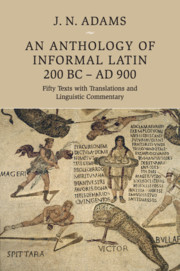 An Anthology of Informal Latin, 200 BC–AD 900
An Anthology of Informal Latin, 200 BC–AD 900 Book contents
Bibliography
Published online by Cambridge University Press: 01 February 2017
Summary

- Type
- Chapter
- Information
- An Anthology of Informal Latin, 200 BC–AD 900Fifty Texts with Translations and Linguistic Commentary, pp. 658 - 688Publisher: Cambridge University PressPrint publication year: 2016


